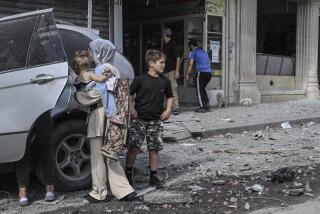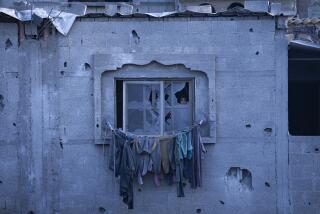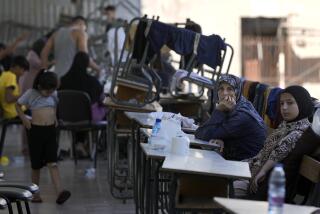Amid Afghan suffering, hard questions of war
More graphics and photos
BANGI, Afghanistan — Grieving refugees fleeing American bombing raids picked their way eastward across the Bangi River yesterday, while a 15-year-old soldier stood watching from the bank, eager to go where they had come from, to take the fight against the Taliban all the way to Kunduz, the hometown he hasn’t seen for two years.
The refugees stopped to talk and told the soldier that about 40 people from their village had been killed in the past two days.
As they recounted what happened, deep reverberations from the continuing U.S. aerial attack, just over the hills behind them, shook the valley. Suddenly, a spare fuel tank from a B-52 bomber slammed into the riverbank barely 200 yards away. It was an extraordinary gleaming artifact from the sky, plunked down in a timeless mountain scene where men walk with wooden staffs and donkeys provide the chief means of transportation.
There were about three dozen refugees, all from the devastated village of Chorikar near the town of Khanabad. Three small boys rode together on one horse. Over the weekend, they said, American planes had bombed their village repeatedly. Of the 40 civilians they knew to have been killed, they said, half were children.
By Sunday evening they had buried the dead -- those they could find -- and resolved to leave, crossing the front line and leaving Taliban-held territory.
“It’s good they’re bombing the Taliban,” said Nur Mohammed, “but why do they have to bomb us?”
“Fourteen of my relatives were killed yesterday,” said Khurshed, 18. “We buried them by sundown.”
As far as anyone could tell, said Mohammed, the bombing had destroyed one Taliban tank but had otherwise inflicted no casualties on the Taliban fighters.
“The Taliban live in the center of Khanabad, along the main avenue,” he said. There are probably 6,000 to 8,000 Taliban fighters in Khanabad, the largest town between the Northern Alliance outpost at Taloqan and the Taliban stronghold of Kunduz, he said, of whom about 1,500 are Arabs and Pakistanis.
The Taliban in the north have been bottled up in Kunduz province, surrounded by Northern Alliance forces. The mayor of Kunduz city has been trying to negotiate a surrender that would provide a safe exit for the foreign fighters among the Taliban, who apparently fear with good reason that they would otherwise be killed by Northern Alliance forces.
Yesterday, the Northern Alliance had moved a few tanks up to the front line, and truckloads of soldiers were heading out of Taloqan. But at the front itself all seemed quiet. Soldiers were lounging and gawking at Western television crews, who were filming a perfectly still and bucolic scene in the direction of Kunduz.
Two soldiers who hoped to hitch a ride back toward Taloqan said they expected a Northern Alliance attack to come soon, because rumor had it that a helicopter that landed in Taloqan on Sunday had come from newly freed Mazar-e Sharif with a load of money to pay soldier’s back wages -- a sure sign, they said, that they were about to be sent into action.
Just then Amir Mohammed walked up to the line with his family. They had left Kunduz early in the morning, on foot. He said that shops and the bazaar are closed, but otherwise there have been no disruptions. The Taliban forces, he said, had been looking after their own problems and leaving the civilian population alone. Most of them were out on the front lines anyway, he said.
“People are escaping in all directions,” he said. But there have been no American air raids on the city.
The people of Chorikar were not so lucky. Back down the Bangi river valley, where the refugees were making their way toward the main road to Taloqan, they described how one bomb over the weekend had destroyed two houses. That was the one that killed most of the children, Nur Mohammed said. Another bomb left a crater 12 feet across, he said.
Quite a few village residents have stayed behind, he said, including the 20 or so wounded in the attacks.
All of this seemed to make little impression on Rashid, the 15-year-old soldier with a Kalashnikov rifle in his hands. Maybe he was 16 -- he said he wasn’t sure -- though he looked more like 14.
Rashid is full of enthusiasm for the fight. A soldier now for two years, it was plain that he had no means of taking a bearing on the villagers’ stories of suffering and death in war.
He left Kunduz with his older brother in 1999, when the Taliban arrived. They seized his family’s home and divided up the land, he said. Rashid, who had dropped out of school after two years, resolved to become a soldier.
The son of a shop owner, he said his parents “gave me their blessing to fight a jihad against those who are not true Muslims,” meaning the Taliban and their foreign allies.
Rashid hasn’t seen his parents for two years, but until the American bombings began he had been able to send messages with people traveling back and forth across the lines. Asked if he would give up being a soldier if Kunduz is taken, he replied: “I’ll keep fighting against terrorism and the people who killed Ahmad Shah Masood.”
Masood was the leader of the Northern Alliance until his assassination Sept. 9 by two Arabs posing as television journalists. His was a death that seems to have galvanized people living in Northern Alliance territory - his picture is plastered on truck windshields, and people talk of avenging the killing.
What would Rashid do if peace breaks out and he has to find something besides soldiering? He looked perplexed by the question. It’s all he has known since boyhood.
“I haven’t thought about it,” he finally replied.
More to Read
Sign up for Essential California
The most important California stories and recommendations in your inbox every morning.
You may occasionally receive promotional content from the Los Angeles Times.










